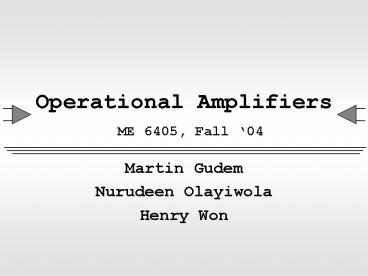Operational Amplifiers ME 6405, Fall - PowerPoint PPT Presentation
1 / 29
Title:
Operational Amplifiers ME 6405, Fall
Description:
Title: Slide 1 Author: Henry Won Last modified by: TA Created Date: 9/15/2004 5:53:43 PM Document presentation format: On-screen Show Company: gt Other titles – PowerPoint PPT presentation
Number of Views:80
Avg rating:3.0/5.0
Title: Operational Amplifiers ME 6405, Fall
1
Operational Amplifiers ME 6405, Fall 04
- Martin Gudem
- Nurudeen Olayiwola
- Henry Won
2
Operational Amplifiers
- Goals
- Introduction
- Characteristics
- Types
- Models VS. reality
3
Introduction
- Most transducers provide analog signals
- Too small
- Too noisy
- Wrong information
- DC offset
Measurement system
4
Amplifiers
- Ideally Increase amplitude without affecting
other properties of the signal
- Voltage gain
- Impedances
5
Terminology
Open loop
Closed loop ? Stabilized signal
6
Ideal Model
- Aid in circuit analysis
- I I- 0
- V V-
- Zout 0
7
Configuration
- 741 General purpose amplifier
Pin-out
8
Internal design
9
The Ideal Op-Amp
- Infinite Input Resistance
- Zero input current
- Zero Output Resistance
- Infinite Gain
- Common Mode Voltage Gain Zero
- Zero Noise / Zero Output Allowed
- Unlimited Bandwith
- Temperature Independent
10
Ideal v. Real Op-Amps
Ideal Op-Amp Typical Op-Amp
Input Resistance infinity 106 ? (bipolar) 109 ? - 1012 ? (FET)
Input Current 0 10-12 10-8 A
Output Resistance 0 100 1000 ?
Operational Gain infinity 105 - 109
Common Mode Gain 0 10-5
Bandwidth infinity Attenuates and phases at high frequencies (depends on slew rate)
Temperature independent Bandwidth and gain
http//hyperphysics.phy-astr.gsu.edu/hbase/electro
nic/opampcon.htmlc1
11
Op-Amps for Math
- Inverting
- Non-Inverting
- Summing
- Differencing
- Integrating
- Differentiating
12
Inverting
An Application Guide for Op-Amps, National
Semi-Conductor, Application Note 20, February
1969.
13
Non - Inverting
An Application Guide for Op-Amps, National
Semi-Conductor, Application Note 20, February
1969.
14
Summing Op-Amp
An Application Guide for Op-Amps, National
Semi-Conductor, Application Note 20, February
1969.
15
Differencing Op-Amp
An Application Guide for Op-Amps, National
Semi-Conductor, Application Note 20, February
1969.
16
Integrating Op-Amp
An Application Guide for Op-Amps, National
Semi-Conductor, Application Note 20, February
1969.
17
Differentiating Op-Amp
An Application Guide for Op-Amps, National
Semi-Conductor, Application Note 20, February
1969.
18
Use of an Op amp
- Filters
- 3 types
- Low Pass Filter (LPF)
- Used to filter higher freq.
- High Pass Filter (HPF)
- used to filter low freq.
- Band Pass Filter (BPF)
- -a combination of LPF and HPF
19
Contd.
- Dual input (dual source and with respect to
ground), - Used in audio equip. control circuits, medical
equipment, etc. - Single input
20
Order of filters
- First order
- Second order
- Our examples show second order
- Filters.
- - What was the order of the filter we used in lab?
21
LPF
This filter is used to remove noise signals that
are above the specified frequency. The frequency
range is given by the equation below Where
ffreq. RR2 CC1
22
HPF
HPF is used to remove all freq. Below the
specified freq. and it is Created by reversing
the position of the capacitor and resistor In a
LPF
23
BPF
This is a combination of the LPF and HPF. It
allows for freq. within the range for the LPF
and HPF.
24
Instrumentation OP Amp
This is used in Situations where output
voltage needs to varied.
25
Analysis of instrumentation op amp
- Vo Vo1 Vo2
- Vo1V1VR
- Vo2 V2 VR
- VR (V1-V2)R/RA
- Vo V1-V22VR (V1-V2)(12R/RA)
26
The use of filters
- Communications
- Removing noise from a power input
- Radio communications
- Infrared/ LED signals transm.
- Etc
27
Conclusions
- One major disadvantage
- Distortion when dealing with really low freq.
ranges
28
Conclusions contd.
- Advantages
- Useable in different industries
- Signal and power amplification
- Simple
- Cheap and easy to build
- Makes life easier
- Math operations
29
References
- www.electronics-tutorials.com
- www.play-hookey.com
- Alcitore, Histand Introduction to Mechatronics
and Measurement Systems































